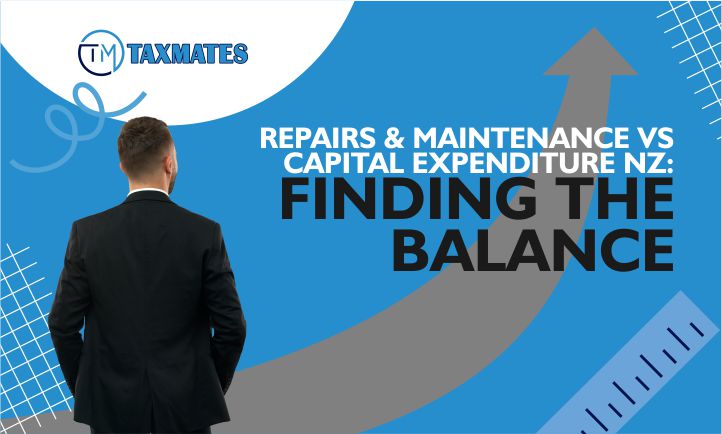In managing assets and properties, the choice between repairs and maintenance versus capital expenditure is a decision that carries significant weight. For the average person, these terms might sound like financial jargon, but they play a crucial role in the long-term well-being of your investments.
Let’s explore this blog of Repairs and Maintenance VS Capital Expenditure NZ, written by Taxmates for benefits, and the often misunderstood tax implications.
Understanding Capital Expenditure NZ
Capital Expenditure, often abbreviated as CapEx, refers to the funds used to acquire, upgrade, and maintain physical assets such as buildings, machinery, or vehicles. It’s the long-term investment that enhances the overall value and longevity of an asset.
Capital Expenditure Analysis: Capital expenditure isn’t just about spending money; it’s an investment strategy. Analyzing the potential returns on this expenditure is crucial for making informed decisions about the future of your assets.
Capital Expenditure vs Repairs and Maintenance
Distinguishing between capital expenditure and routine repairs and maintenance is vital. Repairs and maintenance are regular, ongoing expenses to keep assets in good working condition, while capital expenditure involves substantial investments that extend the asset’s life or improve its efficiency.
Capital Nature Expenditure: Understanding capital nature involves recognizing expenditures that result in lasting benefits beyond the current fiscal period. It’s a concept that influences financial decision-making and strategic planning.
Return on Capital Expenditure: The return on capital expenditure measures the profitability of an investment. Return on Capital Expenditure (ROCE) is a financial metric used to assess the profitability of investments in capital assets. It is calculated by dividing the net operating profit by the capital employed and expressed as a percentage.
Evaluating ROCE helps businesses make informed decisions about the efficiency and effectiveness of their capital investments. Maximizing ROCE involves optimizing operational efficiency, reducing costs, and ensuring that capital expenditures generate significant returns.
Capital Expenditure Accounting: This involves applying accounting principles to record and report capital expenditures accurately. Capital expenditures are typically long-term investments in assets that provide benefits over an extended period.
Proper accounting ensures transparency, compliance with financial reporting standards, and accurate representation of a company’s formation and financial health. It involves capitalizing costs related to acquiring, improving, or maintaining assets, and amortizing or depreciating them over their useful life.
Capital Improvement vs Repair: Distinguishing between capital improvements and repairs is crucial for financial decision-making. Capital improvements enhance the value or extend the life of an asset, while repairs are necessary for routine maintenance. Accurate classification is vital for financial reporting, tax implications, and understanding the impact on a company’s financial statements.
Depreciation Repair vs Capital NZ: Focuses on the tax implications of depreciation on repairs and capital expenditures in New Zealand. Depreciation represents the gradual decrease in the value of an asset over time. Understanding the tax treatment of repairs and capital expenditures helps businesses make strategic decisions to minimize tax liabilities.
Tax Deductibility NZ
Explores the concept of tax deductibility in New Zealand, emphasizing how expenses related to repairs and maintenance can be leveraged. Properly categorizing expenses and understanding tax regulations allows businesses to optimize deductions, reducing overall tax liabilities.
Repairs and Maintenance Tax Deductions
Unravels the tax benefits associated with routine repairs and maintenance expenses. Demonstrates how these expenses can be turned into valuable deductions, positively impacting a company’s financial health by lowering taxable income. Encourages businesses to leverage these deductions for improved cash flow and profitability.
Navigate IRD Guidelines
Considering and adhering to Inland Revenue Department (IRD) guidelines is essential for staying on the right side of the law. Explore these key principles to ensure compliance and financial well-being.
Frequently Asked Questions
1. What qualifies as deductible repairs and maintenance in NZ?
Deductible repairs and maintenance typically include expenses incurred to keep an asset in its existing condition or to restore it to its original state. Examples include fixing leaks, repainting, or replacing worn-out components. It’s essential to ensure that the expenses are necessary for ongoing upkeep and not considered capital improvements.
2. How does the IRD differentiate between repairs and maintenance and capital expenditure?
The Inland Revenue Department (IRD) distinguishes repairs and maintenance from capital expenditure based on whether the expenditure is aimed at preserving the asset’s existing state (deductible) or enhancing its value or extending its life (capital). Regular upkeep costs are usually deductible, while significant improvements or enhancements are considered capital and may need to be capitalized and depreciated over time.
3. Can I deduct the cost of improving a newly acquired asset?
The cost of improving a newly acquired asset falls under capital expenditure rather than deductible repairs. The expense is an enhancement that increases the asset’s value or extends its useful life. Instead of an immediate deduction, the cost is typically capitalized and depreciated over the asset’s useful life.
4. What is the low-value asset rule for deductions in NZ?
The low-value asset rule allows businesses to claim an immediate deduction for assets costing $5,000 or less. This simplifies the treatment of lower-value assets, making it easier for businesses to manage and claim deductions without depreciation over several years.
5. What is the difference between repairs and maintenance and capital expenditure?
Repairs and maintenance involve routine expenditures to keep an asset in its existing condition and are generally deductible. On the other hand, capital expenditure involves significant improvements or enhancements that increase an asset’s value or extend its life, and these costs are typically capitalized and depreciated.
Conclusion
As property owners and investors, finding the delicate equilibrium between repairs and maintenance and capital expenditure is a task worth mastering.
By understanding the intricacies, navigating tax implications, and following the IRD guidelines, you can ensure the longevity and profitability of your assets. Or we strongly suggest consulting with tax services NZ to avoid any financial loss.

